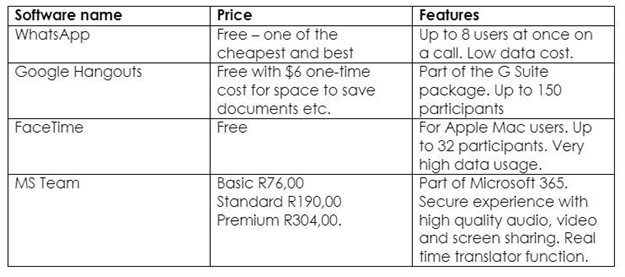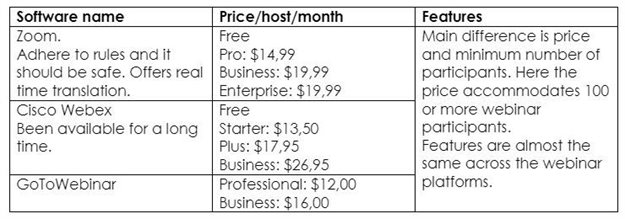NPO Inyathelo recently held a free webinar on cost-effective and efficient webinar solutions. The organisation has provided tips not only for other NPOs, but also for other organisations considering hosting a webinar, while keeping costs down.

L-R: Bayanda Gumbi, database officer; Feryal Domingo, operations director; and Jacques Swart, operations coordinator, Inyathelo.
“Inyathelo staff began working remotely on 18 March – it was as new to us as it was for many,” say operations director Feryal Domingo and operations coordinator Jacques Swart. They presented the webinar, backed up by database officer Bayanda Gumbi. “We had to ‘get on our bicycles’ very fast regarding the technical and cost options of various online collaborative services.
“We were astounded when, early on, we tallied up the unplanned cost of multiple video calls and realised that each video meeting was using an average 1GB. While some people in our sector have fibre, others work off phone data. At the end of the day it is about rands and cents, and most non-profits (and companies) have to manage these extremely carefully.”
The following table illustrates how various service providers’ data costs can add up:
The technical resources required for a webinar are a video- and audio-enabled laptop or desktop; a webinar hosting platform/service provider; and a stable internet connection with a minimum 10mbps line.
“Invest in a headset and microphone. And if you are struggling, remember that most systems are very easy to run and offer an array of support videos to teach you,” says Swart.
The costs and features of popular apps were compared for smaller groups:
For larger audiences of about 100 participants, Zoom, Cisco WebEX and GoToWebinar were considered. (Skype accommodates 50 participants.)
“It is also important to select the appropriate video quality for your needs, as this can significantly increase the amount of data you use,” says Swart. “Be respectful that while some people have paid-for data allowances, others are paying in their own capacity. Tax on data is also high, taking up almost 30% of a data allowance.”
He gave examples of Zoom data usage both on a one-to-one call, and meetings between more than two people:
Example of Zoom data usage on 1:1 call
Example of Zoom data usage on group call
It takes about 10 days to roll out a webinar, taking into account the workshop concept; plan and presentation of material; invitations and registration of participants; ensuring equipment is in good order; and addressing in-house capacity and capability.
“To keep costs down, use the basic equipment that already exists in your place of work such as a smartphone, or video- and audio-enabled laptop or desktop. You will also need a stable internet connection and a webinar host subscription ‒ the free subscription option may be enough for 50-100 participants. Packages can be graded up or down as the need arises.”
Isabel Papadakis 19 May 2020 Professionalise the experience by taking note of the following tips:
Measure success: Decide on your key performance indicators - what you want the webinar to achieve, such as a specific number of qualified business leads and revenue amount.
Promote on the right channels: When marketing your webinar, the optimal channels for a good response are email, partner co-marketing and employee/personal networks. Social media such as Facebook and Twitter are not as effective. “Never just send out a link to a blanket audience, or the webinar could be hijacked. Email it separately,” says Swart.
Promote at the right time: Start the promotion four weeks before your webinar. Promote on Tuesdays – 24% of all registrations occur on that day. Issue invitations early in the morning as registrations spike at 8am-10am. Increase the promotion one week before the webinar – 69% of registrations occur the week before the event, with 33% of registrations taking place the day before the webinar.
Capture registrations: Design an attractive registration landing page ‒ including a video here can increase conversions by as much as 80%. Add only form fields that are absolutely necessary. Create urgency – use language that motivates your audience to register now. Include your contact details as your company phone number or email address builds trust and boosts credibility.
Technical issues: The day before the webinar, the hosts should test all their own technical equipment and have someone tech-savvy test the panellists’ systems. All organisers and panellists should log into the webinar and do audio and video checks. One hour before, run the test again.
Engage your audience: Don’t talk at participants ‒ talk with them. Introduce tools such as polls and surveys, and video clips, to keep interest high.
Sandisiwe Gugushe 13 May 2020 “You can continue to derive value from your webinar by recording the live version and offering an on-demand version,” says Swart. “Host your webinar on third-party platforms, such as GoToStage, for greater reach. Create multiple blog posts from the content shared during the webinar. Turn your webinar into a SlideShare and turn quotes, statistics, and key takeaways into social media posts. You could also create an e-book and short how-to videos.”































